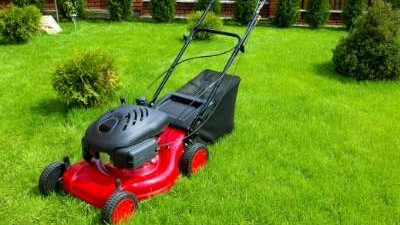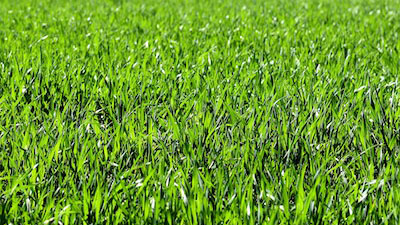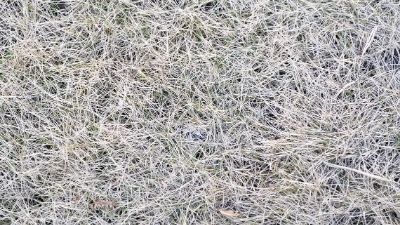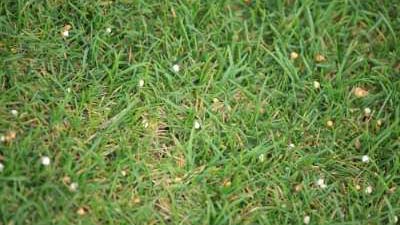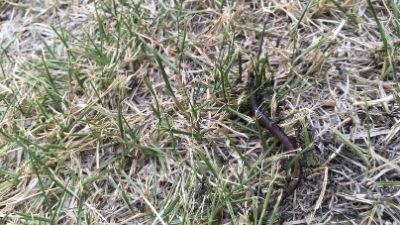Weed Control Options for Residential Lawns in Utah

An important aspect of landscape maintenance includes suppressing lawn weeds. These include both broadleaf and grassy forms, which may disrupt the uniformity of turf. Weed prevention through proper turf establishment and maintenance is the best practical approach for long-term weed control, and is less expensive than controlling weeds later. Aspects of prevention include using best management practices such as proper mowing height along with irrigation and nutrient management. In certain situations, herbicides are an appropriate tool for weed control. However, herbicides should not be used as a primary, longterm option, or as a substitute for appropriate prevention.
Introduction to Lawn Weed Prevention
The adage, “An ounce of prevention is worth a pound of cure” is very applicable when it comes to weed control. There is less expense in both time and resources to control weeds prior to the time they become a problem. Additionally, consider that keeping weeds out of lawns is both an individual and community effort and involves a host of techniques including:
- Cleaning mowing and maintenance equipment
- Filtering/monitoring irrigation water
- Evaluating top soil contaminants
- Using only weed free compost
- Buying and planing high quality weed free seeds and plants
- Consistently scouting your yard for new weeds
- Working with neighbors so you, or they, are not the source of each other's weeds
It is important to identify the weeds, both by common and scientific name, so that the weed’s lifecycle, reproductive strategies, and control methods may be understood. Most common turf weeds can be identified at the USU Extension website Common Weeds of the Yard and Garden.
Establishing Turf

Properly preparing the soil before turf is planted offers the best results. This allows the turf to establish more quickly and outcompete weeds. Conversely, lack of preparation often results in continuous weed problems. Some important steps to consider include:
- Soil testing
- Managing existing weeds
- Applying compost
Soil testing reveals soil nutrient levels and potential problems such as high pH and salinity. For further information on soil improvement and testing visit: www.usual.usu.edu.
Managing already existing weeds allows turf to establish by maximizing available sunlight and reducing competition for soil nutrients and moisture. Control newly germinated and annual weeds with limited tilling or soil cultivation. Perennial weeds often require application of an herbicide to do so. Incorporating compost into the soil before laying sod or seeding can help create a healthy soil environment for turf establishment. Adding compost encourages growth of beneficial soil microorganisms, improves drainage in heavy soils, and increases the water and nutrient holding capacity of sandy soils. Apply 2-3 inches of compost and incorporate it to a depth of 6 inches to improve soil before planting turf.
Preventing Weeds in Established Turf Using Best Managment Practices
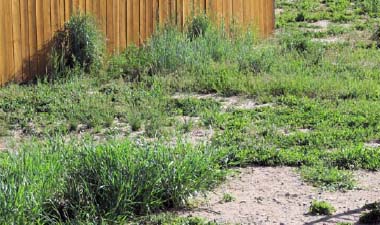
The goal of proper lawn care is to assist the grass in outcompeting weeds using management techniques that favor turf. Cultural practices that include appropriate mowing height, efficient irrigation scheduling, proper fertilization practices, and aeration help create an environment in which turf can almost always outperform weeds. For specific details on lawn management access the following fact sheet entitled Basic Turfgrass Care. A brief summary of proper turf management practices is provided below.
Mowing
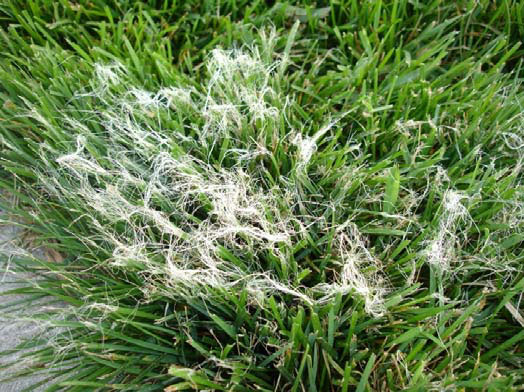
Cool season turf, such as Kentucky bluegrass or tall fescue, should be mowed every 5 to 7 days at a height of 2½ to 4 inches to ensure that no more than 1/3 of the grass blade is removed at each mowing. Also, make sure that the mower blade is sharp and the mowing pattern varies every time the lawn is mowed (Kopp and Johnson, 2011).
Irrigation
Deep, infrequent irrigation promotes deep roots and increased drought tolerance. Conversely, shallow, frequent irrigation promotes the opposite and allows weeds to move in. The lawn’s water needs vary greatly according to outdoor temperatures and soil type. Instead of setting the sprinkler clock once each year, consider outdoor temperatures and soil type to determine when to irrigate. Some ways to judge when turf requires irrigation include:
- Leaving behind footprints in turf because grass blades do not spring back quickly after foot traffic.
- Brown spots appearing in certain areas. Often, this is due to turf beginning to go dormant due to lack of water. However, always investigate brown spots to ensure fungal disease or insect pests are not the cause.
- It becomes difficult to insert a screw driver with a long shaft (6-8 inches) deeply into the soil. This method is not useful for rocky soils.
When footprints, dry spots, or the screw driver test indicate it is time to irrigate, add ½ inch to 1 inch and of water so that water penetrates into the soil 6 to 12 inches deep (Kopp and Johnson, 2011). Contact your local USU Extension office for specific irrigation practices and schedules for your area. The Basic Turfgrass Care fact sheet also offers sound advice concerning irrigating the lawn.
Nutrient Management
It is common to fertilize grasses every few months or according to calendar dates, whether turf needs it or not. Doing so can actually allow some weeds that are better adapted to high nutrient levels and hotter temperatures to outcompete turf. A better practice is to fertilize according to how turf is used and the nutrients that may already be present in the soil, as revealed by soil testing. In most residential situations two fertilizations per year with nitrogen fertilizer is sufficient (Beddes and Kopp, 2012). For further information concerning fertilizing the lawn, access the following fact sheet entitled Lawn Fertilizer for Cool Season Turf.
Consistent Observation
Weeds in turf are objectionable because they disrupt the uniformity of the lawn and may add color (yellow dandelion to green lawn) or different looking leaves (i.e., quackgrass, tall fescue, or orchardgrass in Kentucky bluegrass). Being observant during mowing, irrigation, and fertilization can permit a property owner to see a small infestation of an invading weed, allowing the weed to be controlled before it takes over large areas.
Herbicide Options
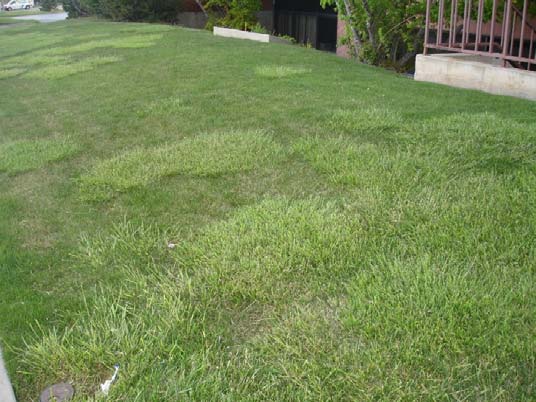
Herbicides applied to turf can be classified as either pre-emergence or post-emergence types. Some herbicides are selective (kill broadleaves but leave grasses or kill grasses and leave broadleaves) and some are non-selective (kill all plants that they contact). Pre-emergence herbicides are preventative and suppress or control germinating seeds. They are not selective for just weed seeds, however, but will also kill or suppress desirable seeds, including newly seeded turfgrass.
Pre-Emergence Herbicides
Pre-emergence herbicides are an excellent weed control option when their application is timed correctly. They are often sold in granular form and may be bundled with fertilizers. Certain pre-emergence herbicides are better suited to control newly germinated annual grasses and some broadleaf weeds in established turf. Common residential herbicide formulations provide between 30 and 120 days of control. Some organic herbicidal products also exist. See Table 1 for summaries of specific products. Locally, it is common to apply a pre-emergence herbicide to lawns in the spring to control warmseason annual grasses like crabgrass. Springtime soil temperatures of 50-55°F indicate that crabgrass will begin to germinate within a few weeks. Beware that these specific weedy grasses emerge from seed in the spring and die at or near the first hard frost in the fall. Existing weedy grasses such as tall fescue are not controlled by pre-emergence herbicides. Often times a second application of pre-emergence herbicides is needed to control summer and autumn germinating weeds if they are excessively problematic.
Post-Emergence Herbicides for Broadleaf Weeds
Many post-emergence products (Weed-BGone type products) selective for broadleaf plants can be applied to turf to control weeds such as dandelions. As long as they are used according to label, they do not harm turf. A limitation of selective broadleaf weed killers is that they must be applied under low wind conditions and at temperatures between 55-85° F to be effective and avoid damage to desirable plants. Labels also provide cautions when using them in the drip line of desirable broadleaf plants or simply state to not use them in these areas at all. Depending on the product, some of these herbicides may remain soil active for several weeks, meaning they can be absorbed through the soil by roots.
Additionally, weeds are best controlled when they are young, actively growing and before they flower. This means that applications of post-emergent products are best made in mid to late spring or early fall depending on the types of weeds to be controlled. See Table 2 for summaries of specific products.
Further, these weed killers should not be applied when temperatures exceed 85 degrees F. They will volatilize, drift in the wind and will sometimes drift up to a few miles. Results from both types of exposure include distorted growth in branches and leaves that may last for a few years, depending on the severity of exposure.
Some commercial grade, soil persistent, broadleaf herbicides are used to control weeds outside the scope of homeowner weed control. Most are not labeled to be applied in residential situations. In general, use by homeowners should be avoided. Post-emergence herbicides are available in both granular and liquid forms. Granular forms are commonly called “weed-and-feed” and are easy to apply, but usually less effective than liquids due to low percentage of active ingredient. To be effective “weed-and-feed” type products should only be used when:
- Weed infestations are light
- When weeds are at an easy-to-kill stage (before the blossoming stage)
- Mainly treating annuals and few to no perennial species
These products should also be applied to slightly wet turf, after sprinklers have run or after a rain storm, so that the granules stick to the weeds instead of dropping off.
Post-Emergency Herbicides for Grassy Weeds
There are few post-emergent, herbicides that can selectively remove even some weedy grasses from desirable turfgrass. These include the few products labeled for Bermuda grass control and other products labeled to control crabgrass and other warm season annual grasses. Otherwise, once a weedy grass spreads, a nonselective herbicide such as glyphosate is usually the only herbicide options to control the infestation. But, remember that such herbicides will also kill the desirable turfgrass.
Timing Herbicide Applications
Use preventive herbicide practices in the spring to control annual weed seeds as they germinate. In the fall, when annual weeds have already gone to seed, spraying dead/dying plants has little effect on weed populations for next year. However, applications of herbicides to perennial weeds in the fall may prove very successful due to the fact that the chemical is translocated down to the roots during this time, providing a more efficient kill. Also keep in mind that turf is not adapted to grow under certain conditions, such as in extreme shade. Unfortunately, there are weeds that tolerate lower light levels than turf. In these situations, weeds can still be controlled but consider some other landscape options such as shade-tolerant groundcovers, mulch, or landscape rock. After all is said and done, if the weed problem is still as bad as it was or worse, know when to admit defeat and start over with new turf, following the establishment steps above. Note that in most cases, though, poor quality turf can be reinvigorated and, over a period of time and with some effort, can come back into full functionality and beauty.
| Table 1. Common Pre-Emergence Herbicides Useon Residential Lawns | ||
|---|---|---|
| Generic Name | Examples of Common Brand Names | Comments |
| Dithiopyr | Dimension, Green Light Crabgrass Preventer | Often bundled with a fertilizer. Offers good to excellent control of annual grasses and moderate to good control of broadleaf weeds. Offers some post-emergence control of newly germinated crabgrass. |
| Prodiamine | Barricade | Often bundled with a fertilizer. Offers good to excellent control of annual grasses and moderate to good control of broadleaf weeds. |
| Pendimethalin | Pre-M, Scott’s Haltz Crabgrass Preventer, Pendulum | Often bundled with a fertilizer. Offers good to excellent control of annual grasses and moderate to good control of broadleaf weeds. |
| Isoxaben | Gallery | Sometimes bundled with a fertilizer. Offers good to excellent control of broadleaf annual weeds and moderate to good control of annual-grasses. Residential versions are usually effective for 3-12 months. Less commonly available in homeowner formulations and may need to be professionally applied. |
| Corn Gluten Meal (CGM) | WOW, Concern Weed Prevention Plus, Espoma Organic Corn Gluten Meal Weed Seed Preventer | Organic pre-emergence option that is usually applied at a rate of 20 pounds per 1,000 square feet (Galligon and Brown, 2002). Mixed results concerning the herbicidal efficacy of CGM have been obtained by researchers (Savonen and Cook, 2006). CGM contains 10% nitrogen (N) by weight, making CGM a good organic fertilizer. |
| Table 2. Common Post-Emergence Herbicides Useon Residential Lawns | ||
|---|---|---|
| Generic Name | Examples of Common Brand Names | Comments |
| 3-Way Products | Weed-B-Gone Max, Trimec, Weed-and-Feed, many others | Combination of 2,4-D, dicamba and mecoprop (MCPP) or other similar active ingredients to obtain a synergistic broadleaf weed killing effect. Often require 2-3 weeks to see maximum results. |
| 4-Way Products | SpeedZone, Weed Free Zone, 4Speed, 4Speed XT, Surge and others | Similar to 3-way products but include carfentrazone, sulfentrazone, pyraflufen ethyl, or similar to enhance effectiveness and reduce the amount of time needed to kill weeds. Wilt down of weeds is often observed within 24 hours. When used during hot weather or at excessively high rates, these products may burn off the top of the weeds before fully penetrating the roots, allowing the weed to regrow. These are additionally sometimes combined with triclopyr to enhance effectiveness against certain weeds. |
| FeHEDTA (a form of chelated iron) | Ortho EcoSense Lawn Weed Killer, Bayer Advanced Natria Lawn Weed Control, Iron X | Marketed as being earth friendly or natural. Will suppress or control many broadleaf weeds. Multiple applications may be needed. |
| Fenoxaprop | Bayer Bermudarass Control, Acclaim Extra | Used to remove or suppress Bermuda grass in turf. It can be rotated with triclopyr for a synergistic effect. Eventual control occurs in of 2 to 3 years. It additionally controls many warm season annual grasses such as crabgrass. |
| Quinclorac (usually combined with other active ingredients) | Weed-B-Gone Max Crabgrass Killer, Trimec Crabgrass Plus Lawn Weed Killer, many others | Organic pre-emergence option that is usually applied at a rate of 20 pounds per 1,000 square feet (Galligon and Brown, 2002). Mixed results concerning the herbicidal efficacy of CGM have been obtained by researchers (Savonen and Cook, 2006). CGM contains 10% nitrogen (N) by weight, making CGM a good organic fertilizer. |
| Sulfentrazone | Ortho Nutsedge Killer | Controls or suppresses nut sedge and Star-of-Bethlehem in cool season turf. Mainly included in 4-way products. Repeat applications are often needed. Sometimes available as a standalone product. |
| Triclopyr (sometimes combined with other active ingredients in 3-way or 4- way products) | Turflon Ester, Weed-B-Gone Chickweed Clover and Oxalis Killer | Triclopyr is more effective against certain weeds such as oxalis and perennial violet than 2, 4-D. It suppresses Bermuda grass and can be rotated with fenoxaprop for eventual control of Bermuda grass. Be sure to follow labeled instructions, especially if potentially spraying near or under the drip-lines of desirable woody plants. |
| Table 3. Broadleaf Weed Species as Turf Problem Indicators | |||||||||
|---|---|---|---|---|---|---|---|---|---|
| Indicator | |||||||||
| Weed Species | Wet | Shade | Mowing Too High | Mowing Too Low | Low Fertility | Dry | Well Drained Soil | Compacted and/or Heavy Clay Soil | Control Options |
| Black Medic | X | X | X | X | Hand-dig minor infestations before plants produce seed. Additionally, use deep irrigation, raise mower height and increase fertility. Apply the pre-emergence herbicide isoxaben in early spring for severe infestations. Spray with a 3-way or 4-way herbicide in early fall. | ||||
| Broadlead Plantain | X | X | X | X | Hand-dig minor infestations. Raise mower height, regularly aerate heavy or compacted soil, and maintain lawn vigor. The pre-emergence herbicide isoxaben effectively prevents germination. Spray live plants with a 3-way or 4-way product in early fall and in spring. Repeated applications will be needed. | ||||
| Bull Thistle | X | Mow at the correct height and maintain lawn vigor. Hand-dig minor infestations. Spray live plants with a 3-way or 4-way herbicide in early fall and in spring. Repeat applications of these are sometimes needed. Do not confuse with Canada thistle. | |||||||
| Burdock | X | Mow at the correct height and maintain lawn vigor. Hand-dig minor infestations. Spray live plants with a 3-way or 4-way herbicide before flowering. | |||||||
| Canada Thistle | X | X | Mow at the correct height and maintain lawn vigor. Do not hand-dig minor infestations until plants are dead. Spray live plants with a 3-way or 4-way herbicide before flowering. Repeat applications are almost always needed. | ||||||
| Chickweed | X | X | X | Mow at the correct height and maintain lawn vigor. Correct irrigation and soil drainage issues. Hand-dig minor infestations. Spray live plants with a 3-way or 4-way herbicide containing dicamba and MCPP (mecoprop). Apply isoxaben in late summer to prevent germination of new plants. | |||||
| Clover | X | Increase soil fertility. Moderately resistant to many postemergent herbicides. Spray with a 3-way or 4-way herbicide in early fall containing triclopry and MCPP (mecoprop). Repeat applications are often needed. | |||||||
| Common Mallow | X | X | Mow below 3 inches and maintain lawn vigor. Hand-dig minor infestations and young plants by wetting soil and removing taproot. Spray live plants with a 4-way herbicide containing carfentrazone in early fall. | ||||||
| Common Speedwell | X | X | X | X | X | Mow at the correct height and maintain lawn vigor. Hand dig before seeds are produced. Spray live plants with a 3- way or 4-way herbicide mid spring or early fall. Apply isoxaben or other pre-emergence products in early spring to prevent or suppress germination of new plants. | |||
| Dandelion | X | X | X | Maintain lawn vigor. Hand-dig minor infestations by removing the plant and taproot. Spray live plants with a 3 way of 4-way herbicide in early fall. Minor infestations need not to be eliminated due to being a valuable bee plant in early spring. | |||||
| Field Bindweed | X | X | X | X | X | Mow at the correct height and maintain lawn vigor. Spray with a 3-way or 4-way herbicide containing quinclorac in early fall. Apply isoxaben or another pre-emergence control product in early spring to prevent or suppress seed germination. Repeated applications of pre and post emergent herbicides over a number of years required. | |||
| Ground Ivy | X | X | Mow at the correct height and maintain lawn vigor by increasing fertility to recommended levels. Increase sunlight penetration. Spray with triclopyr or a 3-way or 4- way herbicide containing triclopyr. Apply isooxaben or another pre-emergence control product in early spring to prevent or suppress germination of new plants. | ||||||
| Knotweed | X | X | X | Mow at the correct height and maintain lawn vigor by increasing fertility to recommended levels. If compaction or heavy clay is problematic, aerate 1-2 times per year. Apply isoxaben or another pre-emergence control product in early spring to prevent or suppress germination of new plants. | |||||
| Moss | X | X | X | Increase sunlight penetration, mowing height and lawn vigor. Allow soil to dry out between irrigations. Several products are available containing forms of chelated iron for control or suppression. | |||||
| Purslane | X | X | X | X | Plants produce profuse numbers of seeds but are outcompeted by healthy turf. Use the pre-emergence herbicide isoxaben or another to control seedling germination. 3-way or 4-way herbicides control germinated plants, but are less effective due to germinating seedlings through the growing season. | ||||
| Prostrate Spurge | X | X | X | Healthy turf out competes spurge. Use the pre-emergence herbicide Isoxaben or another to control or suppress germination. 3-way or 4-way herbicides control living plants, but is less effective due to vast amounts of seeds germinating throughout the growing season. Hand-dig minor infestations. | |||||
| Perennial Lawn Violet | X | Hand-dig minor infestations. Be careful to remove all roots. Larger infestations can be controlled using 3-way and 4- way herbicides containing triclopyr. More than one application may be needed. | |||||||
| Red Stem Filaree | X | X | X | This weed is out competed by healthy turf. Hand digging additionally is a good control option. It is moderately resistant to many 3-way herbicides. A 4-way herbicide may offer better control. Isoxaben or another pre-emergence control product can be applied late summer to control/ suppress germination. | |||||
| Sedges | X | X | Sedge control is difficult once plants are established. Consistent, repeated digging will eliminate plants in 1 to 2 years. Some herbicides are available that will selectively remove sedge species from lawns including halosulfuron (Sedge Hammer) and sulfentrazone (Ortho Nut Sedge Killer). Others exist. | ||||||
| Teasel | X | X | Remove small populations by hand digging. Do not leave roots. 3-way and 4-way herbicides are also effective. | ||||||
| Yellow Woodsorrel (Oxalis) | X | X | X | A vigorous lawn out competes woodsorrel. Otherwise, once established, most selective lawn weed herbicides are only moderately effective at control, where repeated applications are needed. Multiple pre-emergence herbicides will control or suppress germination. Some products may be available to professional applicators that effectively eliminate the weed. | |||||
| Annual Bluegrass | X | X | X | X | Apply a pre-emergence herbicide effective against weedy grasses in late summer (Table 1). Existing patches may be removed using glyphosate or another nonselective herbicide. In extreme situations, ethofumesate (Prograss) selectively removes annual bluegrass from many desirable turf species. More than one application is needed. Hire an experienced professional, due to narrow margins for error. | ||||
| Bermuda Grass | X | X | X | Actively grows when daytime temperatures are above 80° F. Spreads by rhizomes, stolons and seed. Remove from turfgrass using triclopyr and/or fenoxaprop (Table 2). Repeated applications are necessary over a period of 2-3 years. During this same time use a pre-emergence herbicide effective against weedy grasses (Table 1). | |||||
| Crabgrass Species | X | X | X | X | X | X | Actively grows when daytime temperatures are above 80° F. Apply a pre-emergence herbicide effective against weedy grasses (Table 1) in early spring and again in mid-summer to prevent germination. Herbicides containing quinclorac (Table 2) control crabgrass but must be applied within a few weeks after crabgrass has germinated. | ||
| Foxtail Species | X | X | X | Actively grows when daytime temperatures are above 80° F. Apply a pre-emergence herbicide effective against weedy grasses (Table 1) in early spring and again in mid-summer to prevent germination. Herbicides containing quinclorac (Table 2) controls foxtail but must be applied within a few weeks after it has germinated. | |||||
| Goosegrass | X | X | X | Actively grows when daytime temperatures are above 80° F. Apply a pre-emergence herbicide effective against weedy grasses (Table 1) in early spring and again in mid-summer to prevent germination. Fenoxaprop, not quinclorac (Table 2) must be applied to control goosegrass within a few weeks after germination. Goosegrass seed heads look similar to crabgrass. The weed additionally seems to be more common in lawns established from sod. | |||||
| Quackgrass | X | X | X | Exclude or suppress quackgrass by maintaining lawn vigor. Once established, repeated applications of a nonselective herbicide (glyphosate) may be the only option for control. | |||||
| Sand Bur | X | X | A summer annual that is problematic in sandy soil. It is out competed by healthy turf. Small infestation can be removed by hand pulling. Otherwise prevent establishment using a pre-emergence herbicide effective against weedy grasses in early spring and again in mid-summer (Table 2). | ||||||
References
- Beddes, T., and K. Kopp. 2012. Lawn fertilizers for cool season turf. Utah State University Cooperative Extension. Logan, UT. Accessed Jan. 17, 2013.
- Galligon, G., and D. Brown. 2002. Corn Gluten Meal: A natural pre-emergence herbicide. University of Minnesota Extension Service. Minneapolis, MN. Accessed Jan. 17, 2013.
- Kopp, K., and P. Johnson. 2011. Basic turfgrass care. Utah State University Cooperative Extension. Logan, UT. Accessed Jan. 17, 2013.
- Savonen, C., and T. Cook. 2006. Corn gluten meal did not prevent weeds from germination in OSU study. Oregon State University Extension. Corvalis, OR. Accessed Jan. 17, 2013.
- Zollinger J. 2012, Control options for common Minnesota landscape weeds. University of Minnesota Extension Service. Minneapolis, MN. Accessed Jan. 17, 2013.
Other Resources
- Pacific Northwest Handbooks
- Common Weeds of the Yard and Garden
Utah State University Extension
Peer-reviewed fact sheet
Authors
Taun Beddes, Extension Associate Professor of Horticulture, Utah County; Kelly Kopp, Extension Water Conservation and Turfgrass Specialist; Ralph Whitesides, Extension Weed Specialist; JayDee Gunnell, Extension Associate Professor of Horticulture, Salt Lake and Davis Counties; Michael Caron, Extension Assistant Professor of Horticulture, Utah County
Related Research






